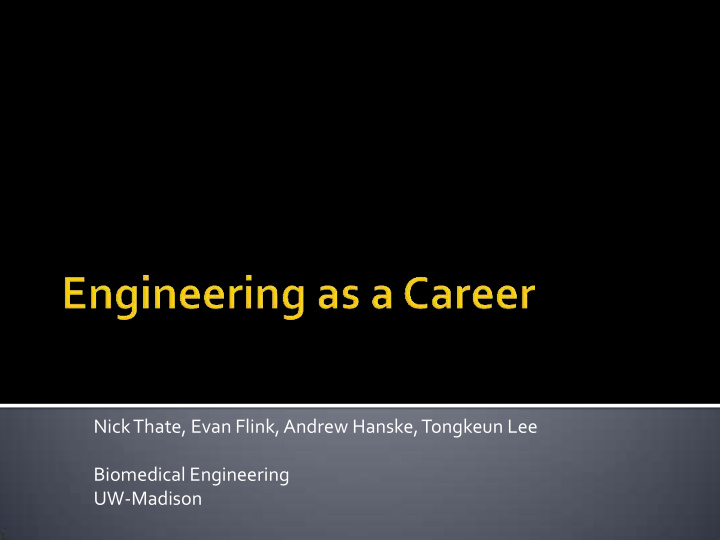



Nick Thate, Evan Flink, Andrew Hanske, Tongkeun Lee Biomedical Engineering UW-Madison
Solving problems Creative thinking Designing new things Making the world a better place Teamwork
Job security Only 2% unemployment rate Good salary Average starting at about $50,000/yr Engaging work Challenging, but rewarding Improve our world
Biomedical Engineering Chemical Engineering Civil/Environmental Engineering Electrical/Computer Engineering Engineering Physics Geological Engineering Industrial/Systems Engineering Materials Science and Engineering Mechanical Engineering
Focus on using chemistry to develop products and processes Applications: Alternative fuel-cells Ultra-strong materials Pharmaceuticals Food science
• Design, construct, and maintain both natural and manmade structures and systems Applications: Construction Infrastructure ▪ Highways, canals, pipelines, etc.
Apply knowledge of electricity and circuitry to create electronics and computers Applications: Power and communications Robotics Personal electronics
Design, production, and manufacturing of mechanical systems and tools Applications: Automotive Heating/cooling Physical design
Engineering Physics Mechanics, physics, nuclear engineering Aeronautics Geological Engineering Use the earth and its natural resources Mining, oil and gas, etc.
Industrial/Systems Engineering Aim to increase efficiency in manufacturing and other processes Materials Science and Engineering Analyze structure and properties of different materials
What is it? It combines many types of engineering with medical and biological applications
Interests Science, both biology and physical sciences Math Problem solving Helping others Enjoy being challenged
Bioinstrumentation Tissue Engineering/Biomaterials Biomechanics Healthcare Systems and Medical Informatics Medical Imaging
Electronics applied to solve medical or biological problems
Myoelectric prosthetics Brain-computer interface Exoskeletons
Biomaterials Study of biological interactions with materials Tissue Engineering Regenerative medicine ▪ Regenerate damaged or lost tissue using various engineering methods
Implants, drug delivery, bandages, sutures Artificial tissue Organs, muscles, cartilage, etc.
Shortage of Donated Organs 100,000 Candidates on waitlist 80,000 Number of people Donors (deceased and living) 60,000 40,000 20,000 0 1990 1995 2000 2005 Year Tissue engineering could solve this problem!
Structure and function of the human body Sub disciplines of biomechanics Orthopedics Motion analysis Ergonomics
Prosthetics Fluid flow throughout the body Study of motion
Healthcare management and electronic information systems Improves security, efficiency, and response/treatment time
Technique that is used to create human body images Useful for diagnosis and functional understanding MRI, PET, CT, X-ray, Ultrasound, etc.
Industry Medical devices Biomaterial development Healthcare systems General engineering Government FDA (Food and Drug Administration) NIH (National Institutes of Health)
Graduate school Masters degree PhD degree Specialized job opportunities Become a professor Medical school Become a doctor Research
The New York Times called biomedical engineering the #1 new job of the next decade Rated as best career in 2011 by U.S. News & World Report Facts from Bureau of Labor Statistics 2010 median salary of $81,540 Projected increase in jobs of 62% from 2010-2020 Other Benefits Improve peoples’ lives Wide range of focuses
MRI-compatible exercise device Magnetic resonance imaging (MRI) Powerful magnetic field interacts with water molecules in your body Body tissues with different densities show up as light and dark spots All body tissues can be seen, not just bones in x-rays
MRI-compatible exercise device Patient exercises while MRI scans are taken Assess effects of exercise on blood flow from the heart to the lungs
MRI-compatible exercise device Device made of non-magnetic materials Plastic, brass, aluminum, and ceramics User pushes on lever arm to lift weight Stepping motion
Engineering is cool, fun, and rewarding You should do it! You have what it takes! Especially biomedical engineering Any questions?
Recommend
More recommend